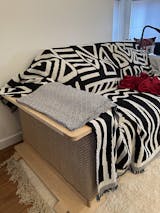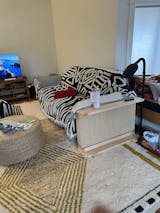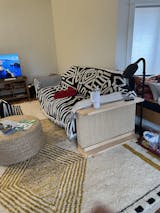Cats scratching your furniture can feel frustrating and even infuriating, but it’s not personal. Scratching is an instinctual behavior, necessary for their physical and emotional health. Understanding why cats scratch and how to redirect them can save your furniture and keep your feline happy.
Let's dive into a few reasons why cats scratch and what you can do to redirect their bad habits.
Why Cats Scratch
Scratching is a natural cat behavior. Even declawed cats will scratch because of their instincts. If they can't scratch, it causes stress, and they'll find a way, even if it's not ideal.
Cats scratch for many reasons including claw maintenance, stretching, territory marking, stress relief and communication.
So they aren't doing it to spite you. It's just their way of telling you something!
Cats All Scratch Differently
Some cats prefer vertical surfaces and others horizontal. Some even scratch while on their backs, that's why the underside of furniture gets shredded.
They also have different texture preferences: sisal mats, carpets, cardboard, and even wood. Next time your cat's scratching, watch them closely. Are they focusing on the arm of your chair? Maybe they like horizontal surfaces. Is it the table legs? Wood might be their favorite.
How to Redirect Your Cat's Scratching
Redirecting your cat’s scratching is about guiding them toward appropriate surfaces instead of punishing natural behavior. The goal is to make the right choice more appealing than furniture or carpets.
Here are the steps to redirect scratching effectively:
-
Place scratchers strategically: Put posts, mats, or the Cat-e-Corner near the areas your cat currently scratches. Cats often scratch where they spend the most time.
-
Use positive reinforcement: Reward your cat with treats, praise, or play when they use the scratcher instead of furniture or your carpet.
-
Attract with catnip or toys: Sprinkle a little catnip on the scratcher or dangle a toy to draw their attention.
-
Gently move them: If you catch your cat scratching the sofa, calmly pick them up and place them on the scratcher. Repeat consistently and reward when they scratch the scratcher instead.
-
Keep furniture less appealing: Use a Cat-e-Corner to attract your cat to that, rather than the furniture! It protects your furniture and acts as an appealing scratcher.
Other Tips for Managing Your Cat's Scratching Behavior
Successfully dealing with your cat’s scratching behavior isn't about stopping it altogether because it's natural, but about giving your cat a safe place to scratch that won't ruin your furniture.
1. Don’t Punish Your Cat
Scratching is natural. If your cat targets furniture, redirect them gently to a scratcher like the Cat-e-Corner. Avoid yelling—use claps, a shake of coins, or toys to guide them.
2. Keep Claws Short
Trim your cat’s nails regularly to minimize damage. Clippers for cats or a vet’s assistance can make the process safe and stress-free.
3. Avoid Declawing
Declawing is major surgery that permanently alters your cat’s paws and balance. It’s painful and can lead to behavior issues. Instead, provide proper scratching outlets.
Final Thoughts on Redirecting Scratching
Scratching is part of what makes cats, well… cats! Seeing your home as their habitat can reduce behavior problems. With the right scratching surfaces, gentle redirection, and understanding, you can protect your furniture while keeping your cat happy and healthy.
Try the Cat-e-Corner to redirect your cat's furniture scratching!










